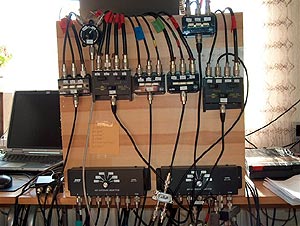Fjerritslev
DXpedition Report
February 5-12, 2005
by Cornel van
Ravenswaaij, Guido Schotmans and Max van Arnhem
Two years after our
first visit to
the famous beverage farm of Wilhelm Herbst in Northern
Jutland, we, Cornel van Ravenswaaij, Max van Arnhem
and Guido Schotmans, decided to return because conditions
are moving slowly to a solar minimum now. Just a
few days after we confirmed our stay, a major solar
storm took place that will go into history as one
of the most intensive ever seen. During the weeks
and months that followed, the sun was never quiet,
resulting in awful conditions on the medium wave
band. Nevertheless, we were in luck: a week or two
before we moved north the sun became quieter.

Max van Arnhem listening
in Fjerritslev |
Similar to our first
DXpedition we left very early in the morning hours
and arrived around 13.45 hours in Fjerritslev in
Northern Denmark. The journey from Belgium and The
Netherlands to the Northern part of Denmark was
easy because the weather was fine. This made it
possible to use the twilight DX-conditions immediately.
After all, it's "plug-and-play" at Wilhelm's
beverage farm. Just unpack your receiver and recording
equipment, hook it up to one of the 21 beverage
antennas and enjoy the DX!

Cornel van Ravenswaaij |
For those unfamiliar
with the beverage farm, we can say it is very enjoyable
to have a warm place and a switchblock connected
to 21 beverage antennas. The beverage antennas are
pointing to all directions and vary between 80 and
300 meters. Also, very important, are the separate
sleeping rooms for every participant. This means
that every one of us could listen or sleep, day
or night, without disturbing the others. And sleep
is important during a one-week listening period.
Our listening equipment consisted of the following
receivers AOR AR-7030, AR-7030 plus and a JRC NDR-545.
Our main interests were mediumwave and the tropical
bands. Cornel also is an avid Non-Directional-Beacon
chaser, so he enjoyed the lower frequencies.

Guido Schotmans |
On mediumwave we
experienced somewhat better conditions than in 2003.
In the afternoons we heard quite a lot of Iranian
stations. Radio Sighet 1404 from Romania was extremely
strong. In 2003 we found Radio Asia from the UAE
on 1575 kHz, now we discovered this station on 1557
khz. New Radio Farda from the UAE on 1575 kHz was
strong. We were a bit astonished that we did only
hear once WYFR Family Radio Taiwan on 1557 kHz.
In 2003 this station was heard almost daily. Radio
Juventus Don Bosco 1640 kHz from the Dominican Republic
was heard the first morning of the week. The reception
of X-band stations was a bit disappointing. Best
reception of North Americans was on the morning
of the 7th of February. Stations from the east coast
were heard until 09.45 hours UTC!

Beverage antennas |
On the tropical
bands we heard familiar and new stations. Marfil
Estéreo 5910,48 from Colombia was booming
in on the morning of the 6th of February, a real
pleasure to listen to some llanera music and many
identifications. Of course we tried to listen to
Indonesia and we were successful to hear the RRI
stations Pontianak, Kendari, Palu and Jambi. We
didn’t hear other Indonesians. Radio Apintie
4990 from Suriname was an almost daily guest in
morning. Also we did some early night listening
sessions and heard several nice signals from Peru
and Bolivia.

Antenna switchblock |
We all brought our
laptops and used them during all listening periods.
Important to mention is that we hardly experienced
any interference from this equipment. We were very
satisfied with the computer program RxWings
developed by Dutchman Jan Arkesteijn. This program
works excellent together with AOR and several NRD
receivers.
It has many features
that are useful while DXing intensively. When you
read this, Jan has just issued an update of this
excellent piece of software. For more information
and free of charge download go to Jan's homepage.

A closer look at how the
antennas are divided |
We used both cassette
and minidisc recorders as we did two years ago,
but now we used the fine virtual recorder RecAllPro
most of the time. Earlier, Guido wrote an article
about this way of recording. His thoughts can be
found in an article
on DXing.info.
Overall, it was
once again an interesting experience that resulted
in a lot of recorded material. So, we have still
some work to do, sorting out our recordings and
writing reception reports.
Back home we continued
chasing the MW and we were surprised by some continuing
good conditions. That makes the pile of reports
to write even higher, but of course, that’s
the way we want things to be!
Our logs are divided into the mediumwave
log, tropical
band log, shortwave
log and NDB
log, all files in Excel format.
Published on March
1, 2005
  
|